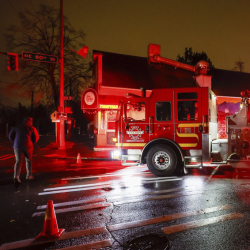The country is pulling out of the Great Recession, but an Associated Press review of 50 balance sheets shows state budgets ravaged by declining tax revenue and bank accounts far leaner than they were when the downturn took hold.
Many face massive liabilities for years to come. Budget and other fiscal data compiled by the AP show that across the 50 states, the $734 billion in cumulative revenue available for the coming fiscal year has dropped by about $34 billion, or 5 percent, from the 2007-08 fiscal year, when the recession began.
Some states are in far worse shape. New Jersey, Nevada, Oregon, Illinois and Louisiana reported deficits that are more than 20 percent of their state's general fund.
Even as many states begin a gradual recovery, analysts expect it will be several years before they reach pre-recession spending levels.
In Georgia, for example, revenue has jumped by more than 8 percent from the previous fiscal year. But Republican Gov. Nathan Deal said he wants to use the bulk of the extra cash to replenish the state's depleted rainy day fund.
"My goal is to make sure we are on a firm financial footing," Deal said. "I think we need to be very, very cautious in our spending."
States that accepted and spent one-time outlays of stimulus money also are bracing for the absence of that windfall this year and are weighed down by enormous pension and retiree health care obligations. Stacked up against those budget pressures, the modest jump in tax collections this spring barely registers in many states.
The AP collected a variety of budgetary and fiscal data from its statehouse bureaus across the country as part of a yearlong effort to examine the fiscal crises playing out in states across the country. The information was collected through early May and will be updated periodically throughout the year by AP's network of state government reporters, providing real-time information about state budgets and finances.
The data provides a detailed look at a moment in time when most states are struggling with deficits, spending cuts and long-term costs that threaten to restrict their spending for decades to come.
Some of the details:
- 12 states started the year with deficits that were equal to 15 percent or more of their general fund, a state's main checkbook for paying day-to-day operations.
- States with the highest per capita number of Medicaid recipients were among those with the largest budget deficits, as a percentage of general fund revenue.
- Seven states are spending 10 percent or more of their general funds to pay for their prison systems.
- The average general fund amount dedicated to colleges and universities was 11.6 percent but varied greatly among states.
- All 50 states have a combined $689.5 billion in unfunded pension liabilities and $418 billion in retiree health care obligations. Five states have unfunded public employee pension liabilities of $50 billion or more.
David Wyss, chief economist at Standard & Poor's in New York, called the pension debt "the biggest headwind that the states will be fighting against" as they try to climb out of budget holes.
"It's worrying because it's such a widespread problem," he said.
States with the largest pension debts could be forced to pay more to borrow money.
The state-by-state numbers gathered by the AP also demonstrate how states spend money and structure their budgets in different ways.
Alabama, for example, spends 54 percent of its state general fund on K-12 education, while in Wyoming and New Hampshire schools receive no general fund money, relying instead on local taxes and money from other state accounts.
Illinois has $30 billion in bond debt, an amount equal to 12.3 percent of the state's general fund, while four states - Idaho, Iowa, Nebraska and Wyoming - have none. Illinois and Hawaii are the only two states with bond debt that accounts for 10 percent or more of annual general fund spending.
An AP analysis of the data shows that 20 states enjoy general fund budgets that exceed their 2007 levels, while the remaining 30 states are still running behind.
Tax revenue in Arizona, hit hard by the housing collapse, remains 19 percent below 2007 levels, the largest difference among the states. Next are California and Florida at 18 percent, and Michigan and Tennessee at 17 percent.
Most state legislatures are approaching their deadlines to have a spending plan approved for the fiscal year that begins July 1. Spending cuts and internal borrowing are the most common steps they are taking to balance their budgets.
In some cases, states have taken steps that actually made their fiscal situation worse.
In Louisiana, for example, the drop in the state's general fund can be tied in part to hefty income tax breaks passed by lawmakers in 2007 and 2008 for middle- and upper-income earners. The permanent tax cuts drained an estimated $580 million the state would otherwise have received this year and similar amounts in future years.
Of particular concern to many states is the end this year of the federal government's stimulus program. The AP data show that states have taken more than $316 billion in federal stimulus money, which has been poured into infrastructure projects, education and keeping costly programs, such as Medicaid, afloat.
In Arizona, which received $6.4 billion in stimulus money, Gov. Jan Brewer and state lawmakers have approved a budget that erases a projected $1.1 billion shortfall with a near equal amount in spending cuts.
The biggest, a $500 million cut of the state's Medicaid program, would implement a freeze to reduce enrollment by 240,000 within a year. The prospect for additional cuts looms as a temporary 1 cent sales tax increase approved by voters last year to help balance the books ends in 2013.
Most states have resisted the temptation to increase taxes during the recession, but there are exceptions.
Then-Gov. Arnold Schwarzenegger agreed to temporary increases in California's personal income, sales and vehicle taxes in 2009. Gov. Jerry Brown, elected last fall, wants to renew those increases for up to five years, to bring in more than $9 billion annually.
New York's general fund shot up $3.5 billion, or 7 percent, largely due to some of the biggest tax and spending increases in state history, including a $4 billion income tax hike on wealthier residents.
Democratic Gov. Andrew Cuomo's initial budget plan for the current fiscal year, released in February, was the first to include an overall cut in state spending in 15 years, despite billion-dollar deficits most of those years. Cuomo had proposed a 2.7 percent cut to the overall budget, including federal money tied to state spending.
But most of the reduction reflected the automatic loss of more than $5 billion in federal stimulus money that runs out this year.
In Illinois, state revenue is 20 percent higher than in 2007 after income taxes were increased by two-thirds, to 5 percent. The $6.8 billion it is expected to generate will allow Illinois to avoid cuts in some areas and spend money on programs that had been neglected - particularly the state's underfunded pension systems.
Gov. Pat Quinn has been criticized for not doing more to reduce spending, and both legislative chambers are working on versions of the budget that would cut costs below his proposed levels.
Illinois state Rep. Frank Mautino, a Democratic, defended the tax increase as a way to help return the state to sound financial footing.
"The whole idea was to get ourselves balanced in four years because it took longer than four years to get ourselves unbalanced and in such a deep deficit," he said. "It will be very hard and very painful for a lot of people who depend on state services, but we can get to the point we need to be at."
---
McCaffrey reported from Atlanta and Schelzig reported from Nashville, Tenn. Associated Press writers Paul Davenport in Phoenix, Melinda Deslatte in Baton Rouge, La., Michael Gormley in Albany, N.Y., and Christopher Wills in Springfield, Ill., contributed to this report.
© 2011 The Associated Press. All rights reserved. This material may not be published, broadcast, rewritten or redistributed. Learn more about our Privacy Policy and Terms of Use.
Portland and Seattle
Free Subscription to Breaking News
Free Subscription to Breaking News























































































































































































































































































































































